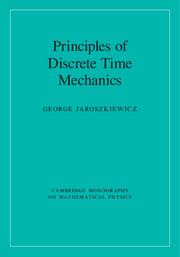Book contents
- Frontmatter
- Contents
- Preface
- Part I Discrete time concepts
- Part II Classical discrete time mechanics
- Part III Discrete time quantum mechanics
- 16 Discrete time quantum mechanics
- 17 The quantized discrete time oscillator
- 18 Path integrals
- 19 Quantum encoding
- Part IV Discrete time classical field theory
- Part V Discrete time quantum field theory
- Part VI Further developments
- Appendix A Coherent states
- Appendix B The time-dependent oscillator
- Appendix C Quaternions
- Appendix D Quantum registers
- References
- Index
18 - Path integrals
from Part III - Discrete time quantum mechanics
Published online by Cambridge University Press: 05 May 2014
- Frontmatter
- Contents
- Preface
- Part I Discrete time concepts
- Part II Classical discrete time mechanics
- Part III Discrete time quantum mechanics
- 16 Discrete time quantum mechanics
- 17 The quantized discrete time oscillator
- 18 Path integrals
- 19 Quantum encoding
- Part IV Discrete time classical field theory
- Part V Discrete time quantum field theory
- Part VI Further developments
- Appendix A Coherent states
- Appendix B The time-dependent oscillator
- Appendix C Quaternions
- Appendix D Quantum registers
- References
- Index
Summary
18.1 Introduction
The Feynman path-integral (PI) approach to quantum mechanics (QM) has proven to be an invaluable technical tool with applicability far beyond the non-relativistic QM from which it sprang (Feynman and Hibbs, 1965). The PI approach is based on a fundamental quantum principle, which is that nothing can or should be said with certainty about a system under observation (SUO) when it is not actually being observed. This is in complete contrast to classical mechanics (CM), which asserts that an SUO exists in a well-defined state at all times, regardless of whether it is being observed or not. It is a remarkable fact that what appears to be a metaphysical point actually underpins the principles of quantum physics.
The quantum principle that we cannot say precisely in classical terms what an SUO is doing when we are not observing it has a powerful corollary: if we cannot say what the SUO is doing when we are not observing it, then we have to allow for the possibility that it could be doing anything, or at least anything that would be consistent with required conservation laws, behind our backs.
Following a lead from Dirac (1933), Feynman developed and popularized a mathematical way of expressing this idea: the path integral. We shall discuss his approach in the case of an SUO consisting of a Newtonian point particle moving in one spatial dimension. Discrete time (DT) comes into the picture right at the start of the formulation.
Information
- Type
- Chapter
- Information
- Principles of Discrete Time Mechanics , pp. 209 - 216Publisher: Cambridge University PressPrint publication year: 2014
